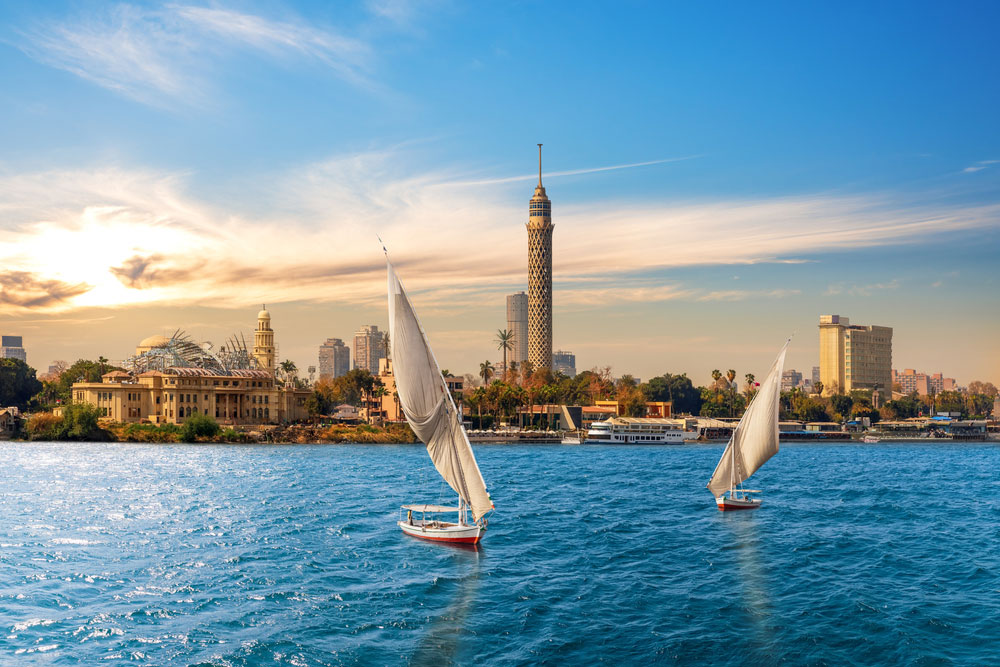Cairo, the bustling capital of Egypt, is a city steeped in history and culture, offering a captivating blend of ancient wonders and modern marvels. Cairo Sightseeing Places, so as you embark on your journey to explore Cairo’s sightseeing places, we’ll provide you with essential information and insights to ensure your visit is both enriching and memorable. Discover important locations also in our site ontravelx.
Essential Things to Know Before You Visit Egypt
TOURING EGYPT TIPS, Egypt, a land of ancient wonders and modern marvels, is a captivating destination that beckons travelers from around the world. Before you embark on your journey to explore the treasures of Egypt, it’s essential to equip yourself with some crucial information to ensure a smooth and rewarding visit. In this section, we’ll provide you with essential things to know before you set foot in this historically rich country.
1. Visa and Documentation
Ensure that you have all the necessary documents in order:
Passport: Check that your passport is valid for at least six months beyond your planned departure date.
Visa: Depending on your nationality, you may need a visa to enter Egypt. Research the requirements and obtain it in advance if necessary.
2. Currency and Payments
Understanding the currency and payment methods is crucial:
Egyptian Pound (EGP): The official currency. Carry cash for small purchases, but major cities and tourist areas accept credit cards.
ATMs: Widely available for cash withdrawals.
3. Language and Communication
While Arabic is the official language, English is commonly spoken in tourist areas. Learn a few Arabic phrases to enhance your experience.
4. Local Cuisine and Dining Etiquette
Egyptian cuisine is diverse and delicious:
Street Food: Don’t miss falafel, shawarma, and koshari from street vendors.
Dining Etiquette: When dining in local restaurants, it’s customary to tip around 10%.
5. Safety Precautions
Stay safe during your trip:
Tourist Areas: Stick to well-traveled areas, especially at night.
Political Situation: Stay informed about the local political climate and follow any travel advisories.
6. Health and Hygiene
Take care of your health while traveling:
Vaccinations: Check for recommended vaccinations before your trip.
Water: Drink bottled water to avoid stomach issues.
7. Local Culture and Etiquette
Respect the local culture:
Dress Modestly: Especially when visiting religious sites, cover your shoulders and knees.
Photography: Always ask for permission before taking photos of locals.
8. Shopping and Bargaining
Shopping is a delightful part of the Egyptian experience:
Bargain: It’s customary to haggle when shopping in local markets and souks.
Quality: Check the quality of goods before purchasing.
9. Transportation in Egypt
Getting around Egypt is relatively easy:
Taxis: Negotiate fares before starting your journey.
Public Transportation: Trains and buses connect major cities.
Domestic Flights: Consider taking domestic flights for long distances.
Traveling to Cairo
1. Cairo International Airport
Places to visit near Cairo airport, Cairo International Airport (CAI) is the primary gateway for international travelers. Here’s what you need to know:
Terminals: The airport has multiple terminals handling domestic and international flights.
Transport to the City: Taxis, airport shuttles, and car rentals are available for transportation to the city center.
2. Entry Requirements and Visa
Best Cairo sightseeing places, Ensure your entry to Egypt is hassle-free:
Visa: Check the visa requirements for your nationality. Some travelers can obtain a visa on arrival, while others need to apply in advance.
Passport: Ensure your passport is valid for at least six months beyond your planned departure date.
3. Currency Exchange
WHAT IS THE TOP PLACES TO GO IN CAIRO WITH FAMILY, Managing your finances in Cairo:
Currency: The official currency is the Egyptian Pound (EGP). Currency exchange facilities are available at the airport and throughout the city.
ATMs: ATMs are widely available for cash withdrawals.
4. Local Transportation
Free things to do in Cairo, Egypt, Getting around Cairo is relatively straightforward:
Taxis: Taxis are a common mode of transportation. Be sure to negotiate fares before starting your journey.
Cairo Metro: The metro system is efficient and cost-effective for navigating the city.
Buses: Buses connect various parts of Cairo, but they can be crowded.
5. Accommodation Options
Cairo offers a range of accommodation options to suit different budgets:
Hotels: From luxury hotels to budget-friendly options, Cairo has a variety of hotels to choose from.
Hostels: Backpackers and budget travelers can find affordable hostels in the city.
6. Safety Tips
While Cairo is generally safe for tourists, it’s essential to stay vigilant:
Stay Informed: Keep up with local news and travel advisories.
Respect Local Customs: Be mindful of local customs and dress modestly, especially when visiting religious sites.
7. Local Culture and Etiquette
Understanding local culture enhances your experience:
Greetings: A common greeting is “As-salamu alaykum,” which means “peace be upon you.”
Tipping: It’s customary to tip around 10% in restaurants and for services.
What to Wear in Cairo?
Places to visit in Cairo at night, When packing for your trip to Cairo, it’s essential to consider the local culture and climate to ensure that you’re both comfortable and respectful of the local customs. Cairo, the capital of Egypt, has a predominantly conservative culture, so dressing modestly is advised. In this section, we’ll provide you with guidance on what to wear in Cairo for a comfortable and culturally appropriate visit.
1. Modest Clothing
Modesty is key when it comes to dressing in Cairo:
Covering Shoulders and Knees: Both men and women should opt for clothing that covers the shoulders and knees. For women, dresses, skirts, and pants that cover the knees are appropriate. For men, long pants are suitable.
Avoid Revealing Clothing: Tight-fitting or revealing clothing should be avoided, as it may be considered disrespectful.
2. Lightweight and Breathable Fabrics
IS EGYPT A GOOD PLACE FOR A FAMILY HOLIDAY?, Cairo has a desert climate with hot and dry summers:
Cotton and Linen: Choose lightweight and breathable fabrics like cotton and linen to stay cool in the heat.
Long-Sleeved Shirts: Long-sleeved shirts can provide sun protection while keeping you cool.
3. Footwear
Unique things to do in Cairo, Comfortable and practical footwear is essential:
Closed-Toe Shoes: Comfortable walking shoes with closed toes are advisable, especially if you plan to explore historic sites and markets.
Sandals: While sandals are suitable for casual outings, closed shoes offer better protection and are more respectful in certain cultural contexts.
4. Head Covering for Women
For women, it’s advisable to carry a headscarf or shawl:
Respect Religious Sites: When visiting mosques or religious sites, women should cover their heads with a scarf as a sign of respect. Some mosques provide scarves for visitors.
5. Respecting Religious Sites
When visiting religious sites, adhere to specific dress codes:
Mosques: Remove your shoes before entering and dress conservatively. Women should cover their heads.
Coptic Churches: Modest clothing is appreciated when visiting Coptic Christian churches.
Cairo Sightseeing Places
Cairo, the capital of Egypt, is a treasure trove of historical and cultural wonders, offering travelers a glimpse into the country’s rich past and vibrant present. From awe-inspiring ancient pyramids to bustling markets and remarkable museums, Cairo has something to captivate every visitor. In this section, we’ll take you on a journey through some of the must-visit sightseeing places in this remarkable city.
1. The Great Pyramids of Giza
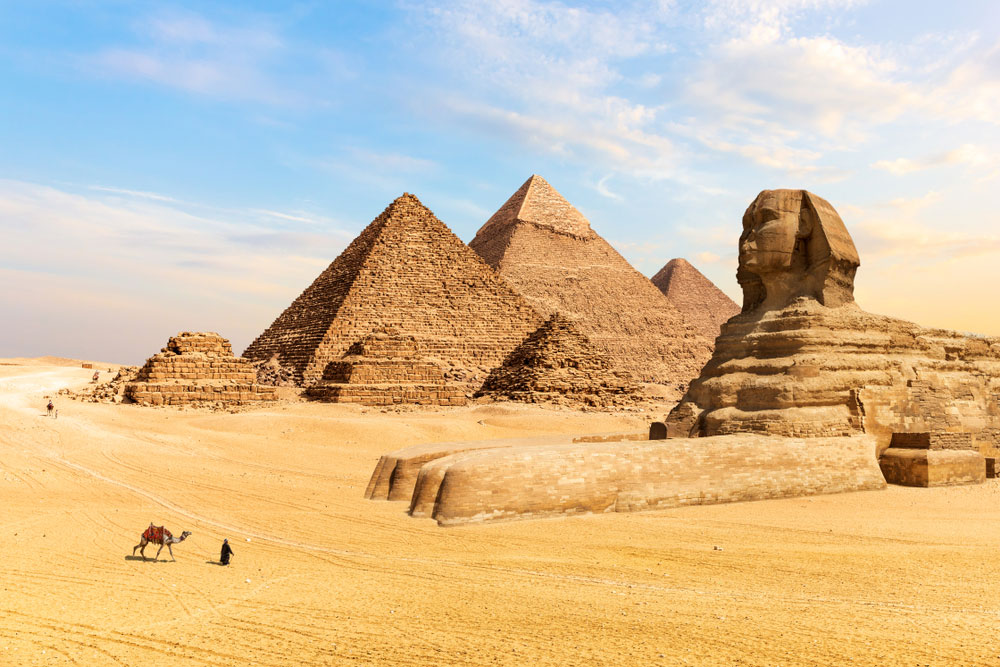
The Great Pyramids of Giza
The largest and most famous pyramid at Giza is the Great Pyramid of Khufu, also known as the Pyramid of Cheops. It was built during the Fourth Dynasty of the Old Kingdom of Egypt, around 2580-2560 BCE.
Khufu’s pyramid was originally 146.6 meters (481 feet) tall, making it the tallest man-made structure in the world for over 3,800 years until the construction of the Lincoln Cathedral in England in the 14th century.
It is estimated that over 2 million limestone and granite blocks, some weighing up to 80 tons, were used in its construction.
2. The Pyramid of Khafre (Chephren):
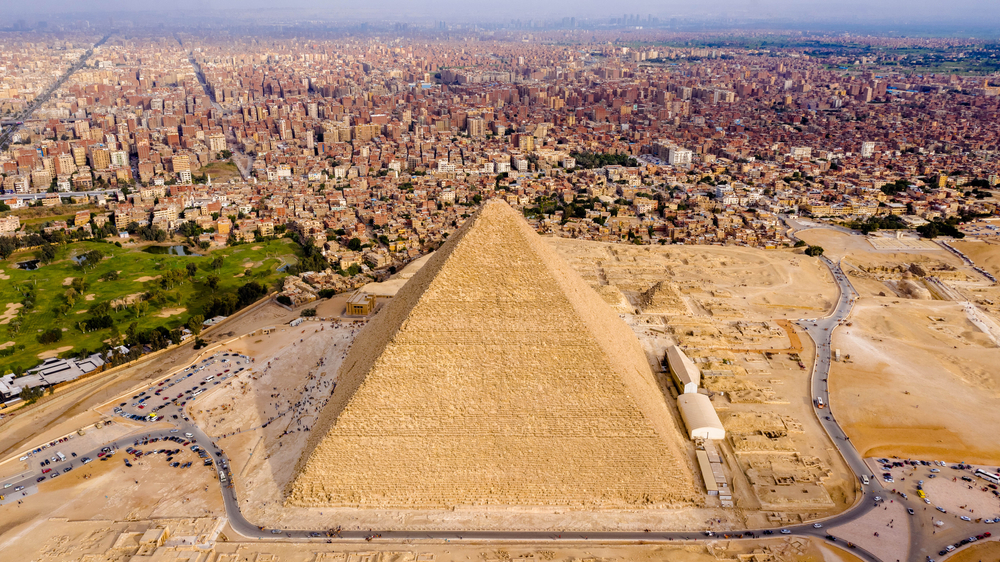
The Great Pyramids of Giza
The pyramid appears taller when viewed from a distance due to its higher location on the plateau and the retention of some casing stones at the top.
Khafre’s pyramid complex includes the famous Great Sphinx of Giza, a colossal limestone statue with the body of a lion and the head of a pharaoh, believed to represent Khafre himself.
3. The Pyramid of Menkaure:
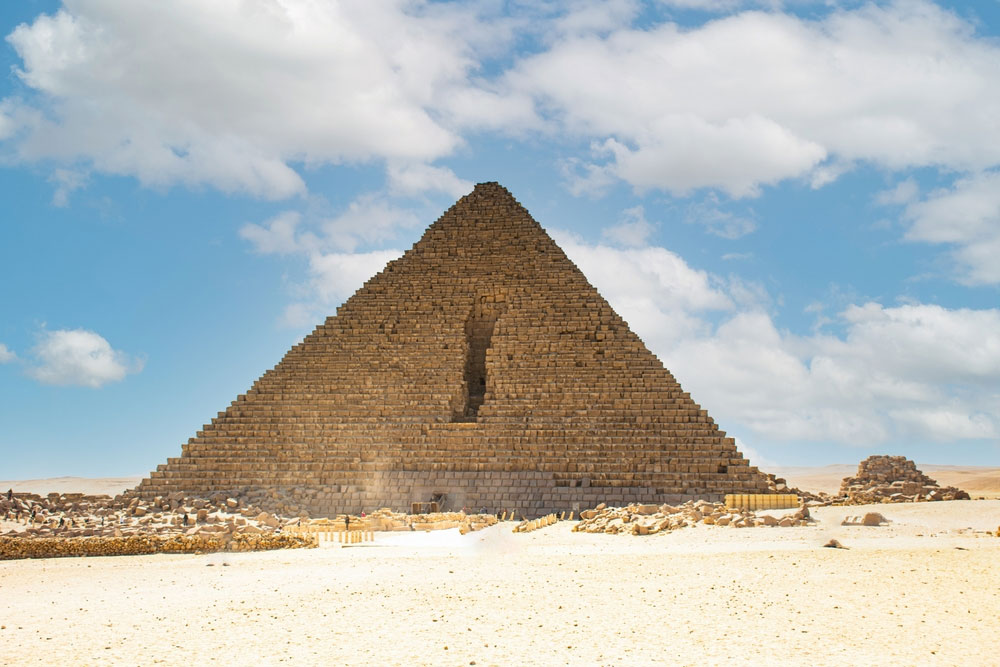
The Pyramid of Menkaure is the smallest of the three main pyramids at Giza and was built around 2510-2490 BCE.
It is distinctive for its three tiers, each with its own casing stones. Like the other pyramids, it contains an inner burial chamber.
Menkaure’s pyramid complex also includes several smaller pyramids for queens and an impressive mortuary temple.
The Great Pyramids of Giza continue to captivate and mystify visitors from around the world. They are not only remarkable engineering feats but also symbols of the ancient Egyptian civilization’s grandeur, architectural prowess, and religious beliefs. Their enduring presence serves as a testament to the enduring legacy of the pharaohs and the enduring wonder of human achievement.
Egyptian Museum
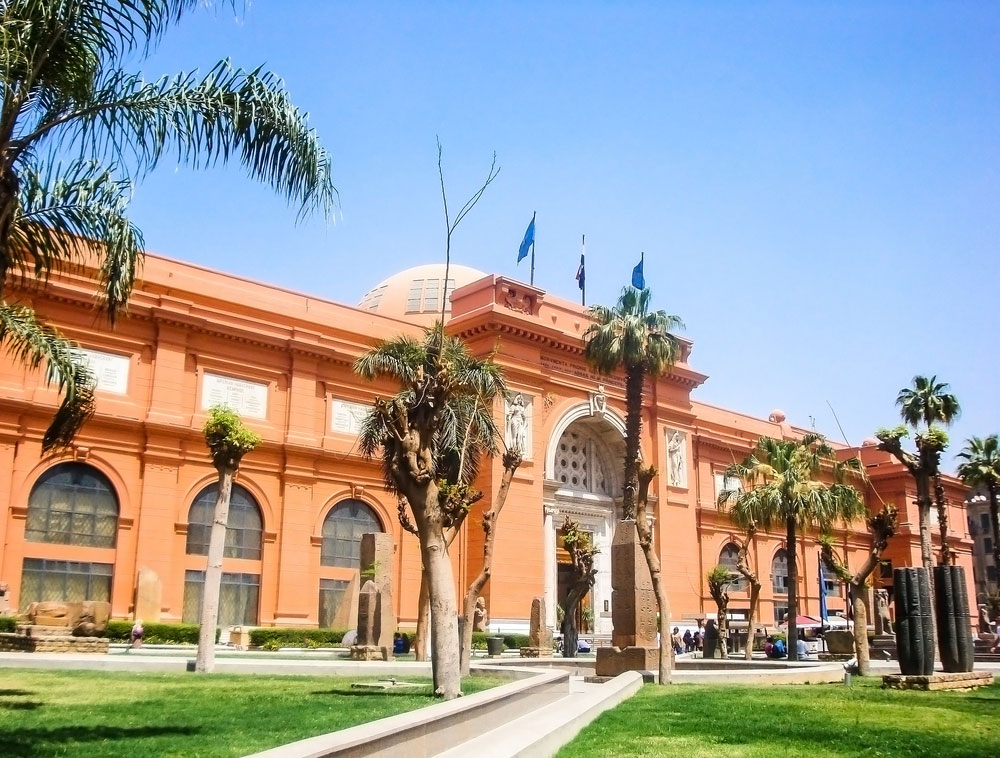
Step into the Egyptian Museum and embark on a time-traveling adventure.
The Egyptian Museum, officially known as the Museum of Egyptian Antiquities, is a world-famous museum located in Cairo, Egypt. It is celebrated for its extensive collection of ancient Egyptian artifacts and treasures, providing a fascinating glimpse into the rich history and culture of Egypt. Here’s an overview of this renowned institution
1. Historical Significance:
TOP PLACES TO GO IN CAIRO WITH FAMILY, The Egyptian Museum was founded in 1902 by French architect Marcel Dourgnon and Egyptologist Gaston Maspero. It was established to house and preserve Egypt’s vast and invaluable archaeological heritage.
2. Location:
The museum is located in Tahrir Square, one of Cairo’s central and prominent locations. Its strategic position makes it easily accessible to visitors from around the world.
3. The Collection:
The Egyptian Museum boasts an exceptional and diverse collection of artifacts spanning thousands of years of Egypt’s history, from the prehistoric era to the Greco-Roman period.
The collection includes a wide array of items such as sculptures, pottery, jewelry, papyrus scrolls, religious artifacts, and monumental statues.
Cairo Tower
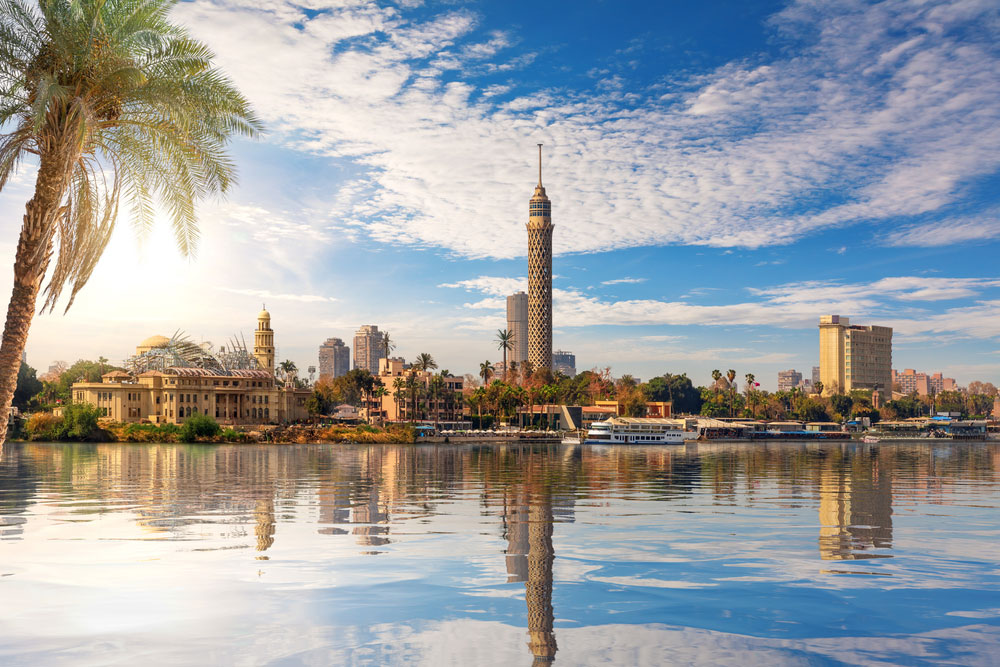
Ascend Cairo Tower for a breathtaking experience that offers panoramic views of the sprawling cityscape.
HOTTEST PLACE IN EGYPT IN DECEMBER, The Egyptian Museum, located in Cairo, Egypt, is one of the world’s most renowned museums, housing an unparalleled collection of ancient Egyptian artifacts and treasures. Here’s a closer look at this historical and cultural treasure trove:
1. History and Location:
The Egyptian Museum, officially known as the Museum of Egyptian Antiquities, was founded in 1902. It was established to house and showcase the vast and invaluable collection of ancient Egyptian artifacts.
The museum is situated in Tahrir Square in the heart of Cairo, making it easily accessible to visitors from around the world.
2. The Collection:
The Egyptian Museum boasts an extensive and diverse collection that spans thousands of years of Egypt’s history, from prehistoric times to the Greco-Roman period.
The collection includes artifacts such as sculptures, pottery, jewelry, sarcophagi, mummies, papyrus scrolls, and statues of pharaohs and deities.
One of the most famous and impressive sections of the museum is the Tutankhamun exhibit, which showcases the treasures discovered in the tomb of the young pharaoh Tutankhamun (King Tut) in the Valley of the Kings.
3. Tutankhamun’s Treasures:
BEST PLACE TO VISIT IN EGYPT IN DECEMBER, The tomb of Tutankhamun, discovered by archaeologist Howard Carter in 1922, held a vast treasure trove of artifacts. Many of these treasures are on display in the museum’s dedicated Tutankhamun gallery.
The collection includes King Tut’s iconic golden death mask, his golden throne, chariots, jewelry, and various personal items that provide a glimpse into the life of an Egyptian pharaoh.
Al-Azhar Park
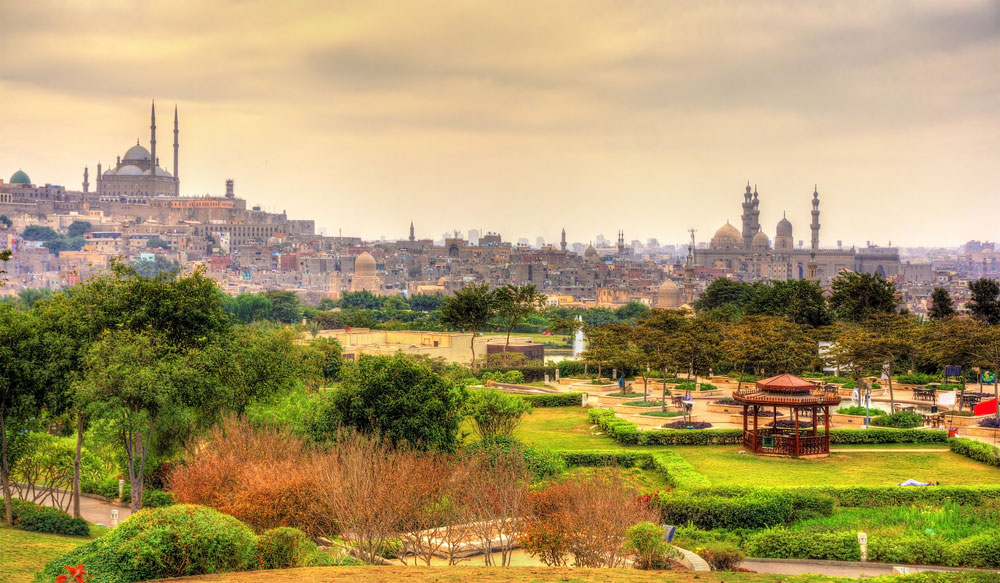
Find respite in the serene oasis of Al-Azhar Park, a green haven in the heart of Cairo.
BEST PLACE TO VISIT IN EGYPT IN DECEMBER, Al-Azhar Park, located in the heart of Cairo, Egypt, is a beautifully landscaped urban park that offers a tranquil escape from the bustling city. Here’s a closer look at this green oasis and its significance:
1. Historical Background:
Fun activities in Cairo for adults, Al-Azhar Park was developed as a part of a larger urban regeneration project in Cairo. It was inaugurated in 2005 and is one of the city’s newer attractions.
2. Location:
The park is strategically situated near historic Cairo, with stunning views of the city’s iconic landmarks, including the Citadel of Saladin and the Sultan Hassan Mosque.
3. Landscaping and Design:
The park’s design draws inspiration from traditional Islamic gardens and landscaping techniques. It features terraced gardens, fountains, water features, and lush greenery.
The park’s serene ambiance and well-maintained grounds provide a welcome respite from the urban hustle and bustle.
Khan El Khalili Bazaar
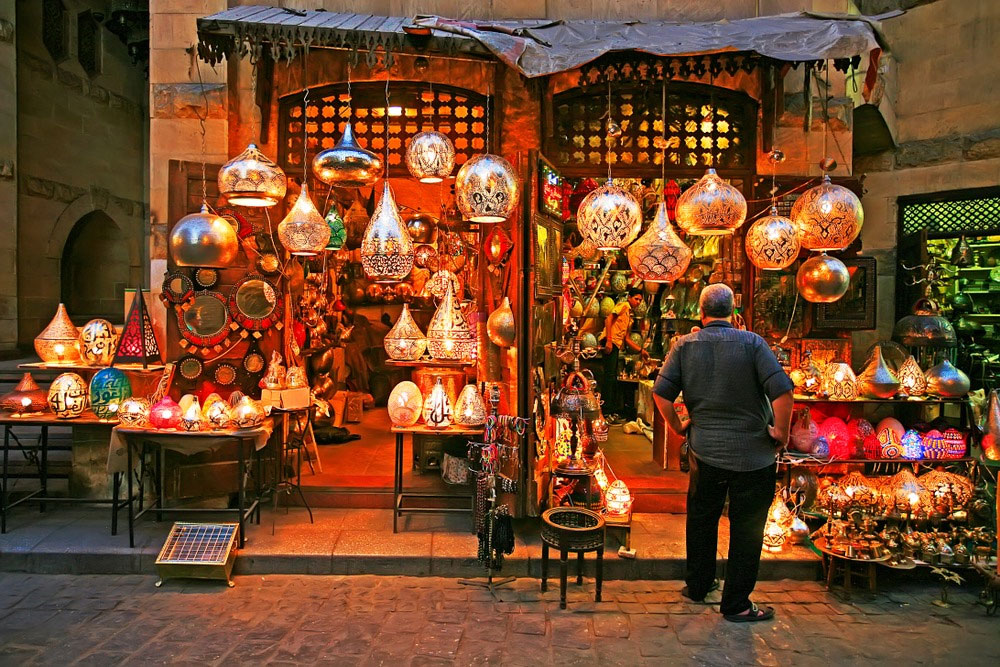
Dive into the vibrant chaos, where centuries-old alleyways are filled with shops selling spices, jewelry, textiles, and trinkets.
Khan El Khalili Bazaar, often simply referred to as Khan El Khalili, is one of Cairo’s most iconic and vibrant marketplaces. Located in the historic heart of the city, this bustling bazaar is a cultural and commercial hub where visitors can immerse themselves in the sights, sounds, and flavors of Egypt. Here’s what you need to know about this renowned market:
1. Historical Significance:
Khan El Khalili Bazaar has a storied history dating back to the 14th century during the Mamluk era. It was originally a caravanserai, a trading post for merchants traveling along the Silk Road.
2. Location:
The bazaar is situated in the heart of historic Cairo, near the Hussein Mosque and the Citadel. Its central location makes it easily accessible and a popular stop for tourists exploring the city.
3. Souvenirs and Shopping:
Khan El Khalili is a shopper’s paradise, offering a wide range of goods. Visitors can browse through shops and stalls selling traditional Egyptian crafts, jewelry, spices, textiles, carpets, clothing, and souvenirs.
Haggle with local shopkeepers for the best prices and take home unique mementos of your visit to Egypt.
Cairo Opera House
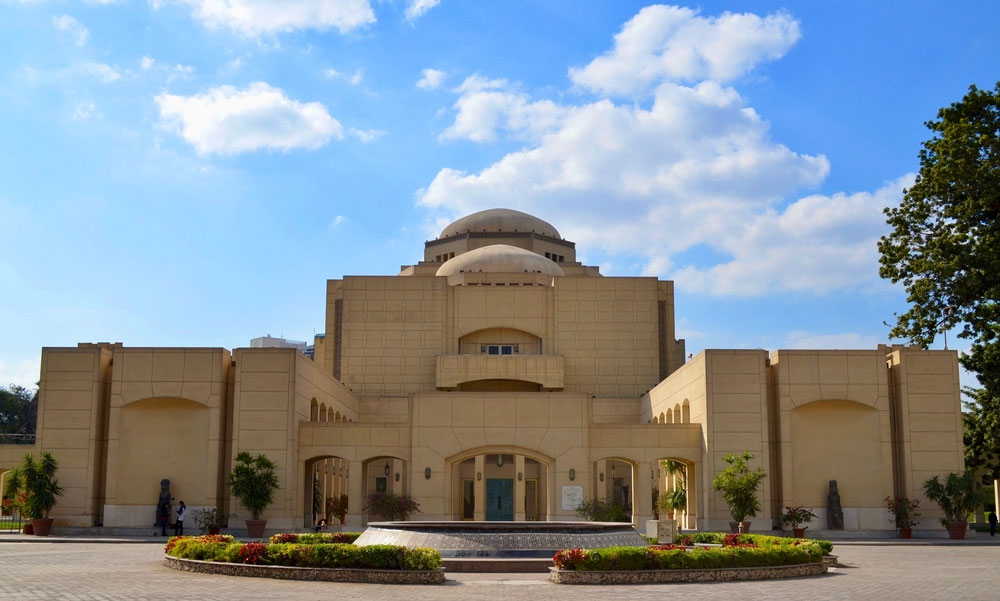
Experience the arts at the Cairo Opera House, where music, dance, and theater performances come to life.
The Cairo Opera House, known as “El Dammah Theater” in Arabic, is a prominent cultural institution and performing arts venue located in the heart of Cairo, Egypt. This magnificent complex plays a vital role in promoting the arts and providing a platform for both local and international talent. Here’s an overview of the Cairo Opera House:
1. Inauguration and Architecture:
The Cairo Opera House was officially inaugurated on October 10, 1988. It was designed by the renowned Egyptian architect Hassan Fathy and built on the Gezira Island in the Nile River.
The architecture of the opera house blends modern and traditional Egyptian elements, creating a visually stunning and culturally significant structure.
2. Cultural Hub:
The Cairo Opera House is a cultural hub and a symbol of Egypt’s commitment to the arts. It hosts a wide range of cultural and artistic events, including opera, ballet, classical music concerts, theater productions, and contemporary dance performances.
3. Performance Spaces:
The complex houses several performance spaces, including the Main Hall, the Open-Air Theater, the Small Hall, and the Arab Music Institute. Each venue is designed to cater to different types of performances and audiences.
4. Diverse Program:
The Cairo Opera House offers a diverse program that includes both Egyptian and international productions. It hosts visiting orchestras, ballet troupes, and opera companies, allowing audiences to experience a wide variety of artistic expressions.
Giza Zoo
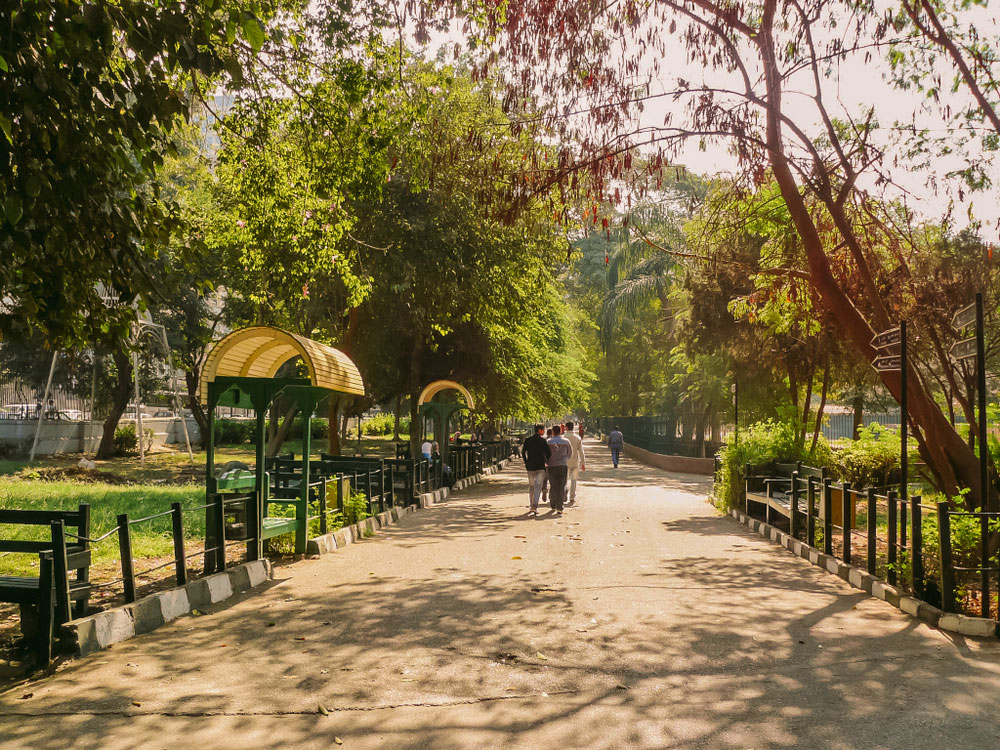
Explore the animal kingdom at Giza Zoo, where you can see a variety of exotic creatures in a lush, green setting.
The Giza Zoo, also known as the Cairo Zoo, is one of Egypt’s oldest and most renowned zoological gardens. Located in the heart of Giza, near the Giza Plateau and the Great Pyramids, the zoo offers a unique opportunity to explore a diverse collection of wildlife while enjoying a peaceful natural setting. Cairo Sightseeing Places, Here’s an overview of this historic and beloved institution:
1. Historical Significance:
The Giza Zoo was founded in 1891 during the reign of Khedive Abbas II, making it one of the oldest zoos in Africa. Its long history and significant location near the pyramids add to its allure.
2. Size and Layout:
The zoo covers a vast area, with beautifully landscaped gardens, tree-lined pathways, and well-designed enclosures that provide a comfortable habitat for its animal residents.
3. Biodiversity and Animal Collection:
The Giza Zoo is home to a diverse range of animals, including mammals, birds, reptiles, and amphibians. Visitors can encounter species from around the world, such as lions, tigers, giraffes, elephants, hippos, and various exotic birds.
The zoo also participates in breeding programs to support conservation efforts for endangered species.
Gezira Island
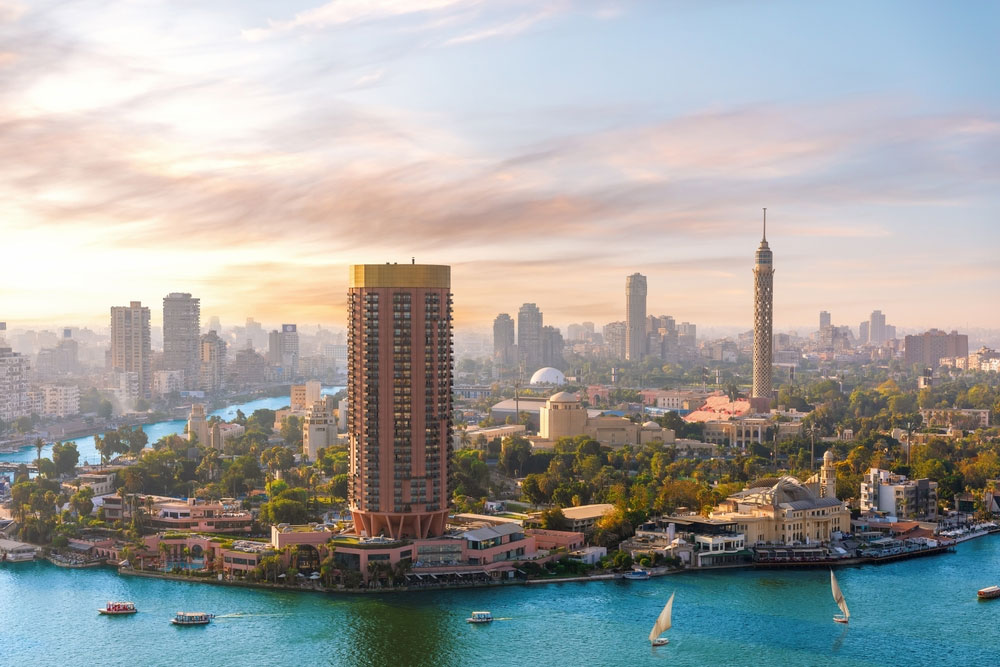
Discover the peaceful ambiance of Gezira Island, Whether you seek a leisurely stroll, a romantic getaway, or a setting for a picnic.
Gezira Island, also known as “Zamalek Island,” is a lush and affluent island located in the heart of Cairo, Egypt. Situated in the Nile River, this island oasis is known for its upscale residential neighborhoods, cultural attractions, and serene atmosphere. Here’s a closer look at Gezira Island:
1. Island Location:
Gezira Island is situated in the Nile River, sandwiched between the districts of Zamalek and Agouza in Cairo. It’s easily accessible from various parts of the city.
2. Residential Oasis:
Gezira Island is predominantly a residential area, characterized by tree-lined streets, elegant apartment buildings, and luxurious villas. It’s a sought-after address for both expatriates and affluent locals.
3. Cultural Attractions:
The island is home to several cultural attractions, including the Cairo Opera House, which hosts a wide range of artistic performances, from opera and ballet to classical music concerts.
The Museum of Islamic Ceramics, showcasing a stunning collection of ceramics and pottery, is also located on Gezira Island.
Wadi Degla Protectorate
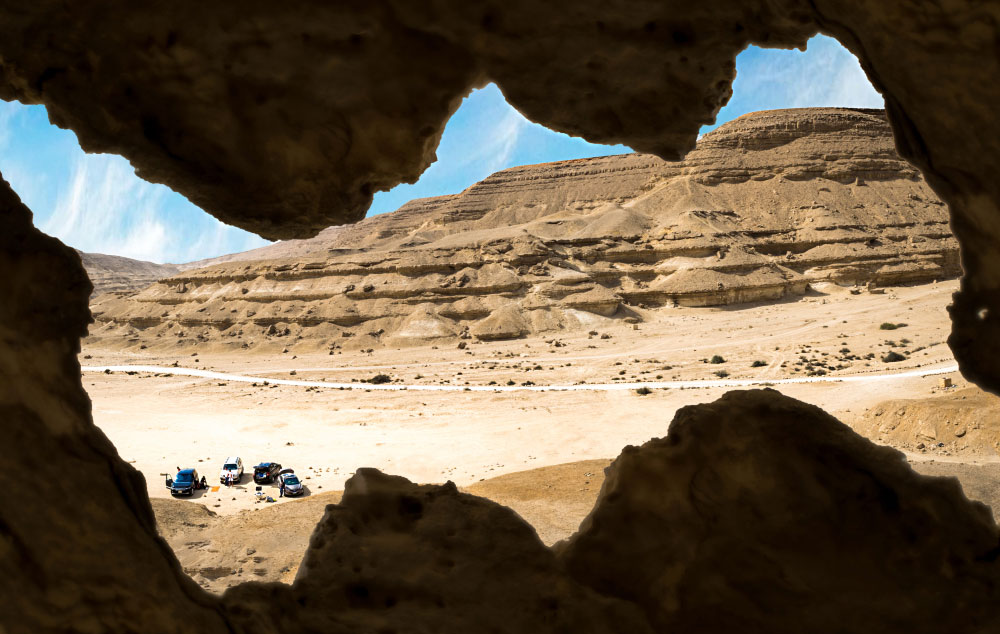
Explore the rugged beauty of Wadi Degla Protectorate, a protected natural area. Hike along its trails.
Wadi Degla Protectorate is a natural conservation area located in Egypt, specifically in the Eastern Desert near the city of Cairo. This protected area, also known as Wadi Degla National Park, offers a unique opportunity for outdoor enthusiasts and nature lovers to explore the stunning desert landscape, hike through rugged terrain, and appreciate the natural beauty of Egypt. Here’s an overview of Wadi Degla Protectorate:
1. Natural Beauty:
Wadi Degla Protectorate is celebrated for its natural beauty, characterized by dramatic desert landscapes, rocky hills, and breathtaking canyons. The area is a striking contrast to the urban environment of Cairo.
2. Protected Area:
The protectorate was established in 1986 with the aim of preserving the region’s biodiversity and natural features. It serves as a sanctuary for various plant and animal species that have adapted to the desert environment.
3. Diverse Ecosystem:
Despite the harsh desert conditions, Wadi Degla is home to a surprising diversity of flora and fauna. Visitors may encounter desert plants, reptiles, birds, and small mammals during their hikes.
The Pharaonic Village
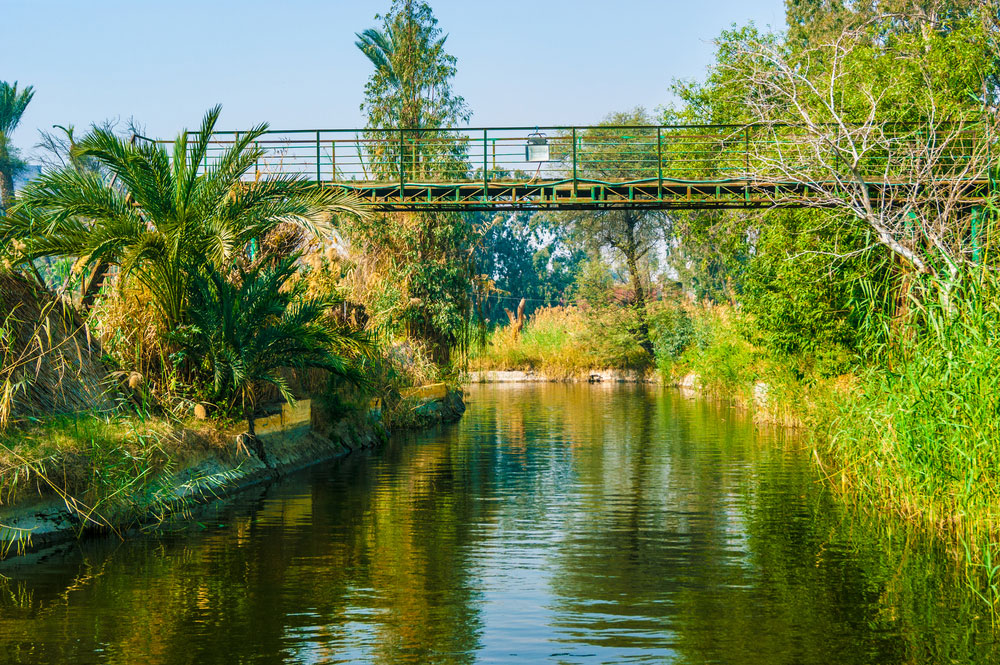
Take a captivating journey through ancient Egypt at The Pharaonic Village, where history comes to life.
The Pharaonic Village is an immersive cultural and historical attraction located in Giza, Egypt. This unique village offers visitors a chance to step back in time and experience ancient Egypt as it once was during the time of the pharaohs. Here’s an overview of what you can expect when visiting the Pharaonic Village:
1. Living History Museum:
The Pharaonic Village is essentially a living history museum that re-creates life in ancient Egypt. It provides a hands-on, educational experience that allows visitors to interact with historical reenactors and artisans.
2. Recreation of Ancient Egypt:
The village is designed to authentically recreate the daily life, customs, and traditions of ancient Egypt, showcasing how people lived during the time of the pharaohs.
3. Themed Exhibits:
The village features a series of themed exhibits and displays that depict various aspects of ancient Egyptian life, including agriculture, art, architecture, and trade. These exhibits are set in a charming and picturesque village setting.
4. Educational Experience:
The Pharaonic Village is an excellent educational destination for both children and adults. Visitors can learn about ancient Egyptian history, culture, and civilization through engaging and informative presentations.
Khanqah of Sultan Baybars Al-Jashnakir
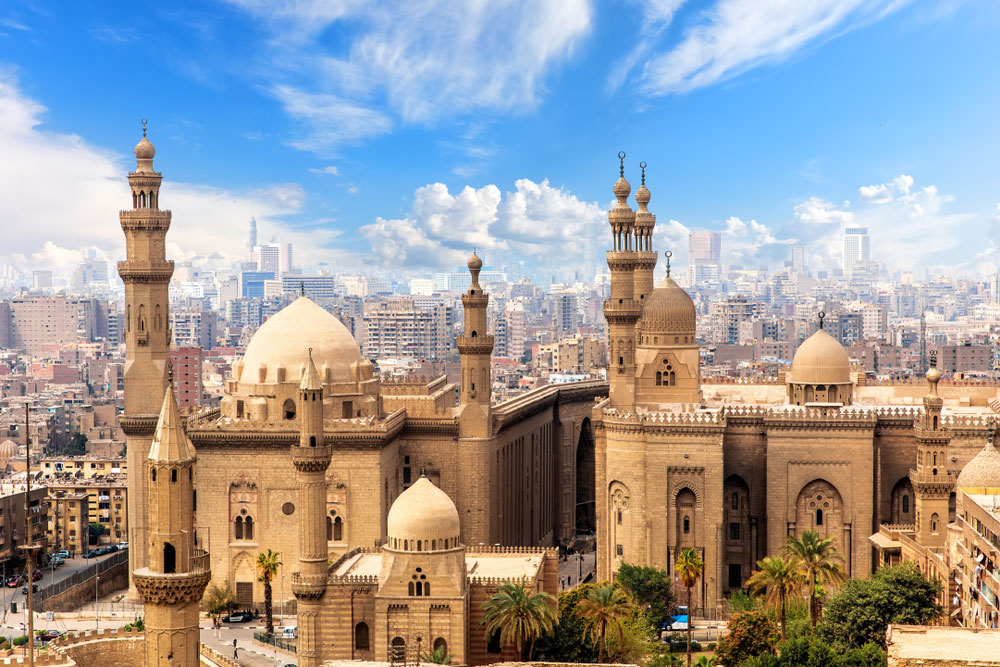
A place of spiritual significance, Admire its architectural beauty and reflect on its cultural and religious importance in Egypt’s heritage.
The Khanqah of Sultan Baybars Al-Jashnakir is a historic religious complex located in Cairo, Egypt. This architectural gem holds significant historical and cultural importance and serves as a testament to the rich heritage of Islamic architecture and religious institutions in the region. Here’s an overview of the Khanqah of Sultan Baybars Al-Jashnakir:
1. Historical Significance:
The Khanqah, also known as a Sufi lodge or monastery, was built in the 13th century during the Mamluk Sultanate in Egypt. It was constructed by Sultan Baybars Al-Jashnakir, one of the prominent sultans of the Mamluk dynasty.
2. Architectural Beauty:
The Khanqah is celebrated for its architectural beauty and intricate design, showcasing the craftsmanship and artistic skills of the period. It combines elements of Islamic architecture with distinctive Mamluk features.
3. Spiritual Retreat:
Historically, Khanqahs like this one were used as spiritual retreats for Sufi Muslim practitioners. They provided a place for prayer, meditation, and communal worship.
4. Religious and Cultural Hub:
The Khanqah served as a center for religious and cultural activities, bringing together scholars, artists, and Sufi mystics. It played a crucial role in the spiritual and intellectual life of Cairo during its heyday.
Interesting Facts About Cairo
BEST PLACES TO VISIT IN NOVEMBER NEAR EGYPT, Cairo, the bustling capital of Egypt, is a city steeped in history, culture, and intrigue. Beyond its iconic landmarks and ancient wonders, Cairo holds a wealth of fascinating facts and stories that make it a truly captivating destination. In this section, we’ll delve into some intriguing and lesser-known facts about this remarkable city.
1. City of a Thousand Minarets
Cairo is often referred to as the “City of a Thousand Minarets” due to its numerous mosques and their distinctive tall towers. The city’s skyline is punctuated with these elegant structures, each telling its own story.
2. Home to the Oldest University
Al-Azhar University in Cairo is one of the world’s oldest educational institutions, founded in 970 CE. It has been a center of Islamic scholarship for over a millennium.
3. Traffic Jam Capital
Cairo is notorious for its traffic congestion, earning it a reputation as one of the world’s most congested cities. Rush hour can be an adventure in itself.
4. The City That Never Sleeps
Cairo truly comes alive at night. The city’s vibrant nightlife includes bustling markets, restaurants, and cafes that stay open late into the evening, creating an atmosphere of perpetual activity.
5. Cairo’s Underground Secrets
Beneath the bustling streets of Cairo lies an underground world of catacombs, tunnels, and hidden chambers. These subterranean treasures provide a glimpse into Egypt’s mysterious past.
6. Astronomical Marvels
Cairo is home to a remarkable astronomical observatory known as the Al-Muizz Street Al-Azhar Park. Visitors can explore celestial wonders through telescopes and attend stargazing events.
7. City of Gates
Historically, Cairo was known as the “City of a Thousand Gates” due to its fortified walls. While the walls are mostly gone, remnants of these gates can still be found throughout the city.
8. An Ever-Changing Skyline
Cairo’s skyline is constantly evolving, with modern skyscrapers and architectural marvels standing alongside ancient monuments. This dynamic blend of old and new is a testament to the city’s enduring spirit.
9. Cairo’s Street Food Delights
Cairo’s bustling streets offer a feast for the senses with an array of delicious street food. From koshari to shawarma, exploring the city’s culinary delights is an adventure in itself.
Best Things to Do in Cairo
Cairo, the bustling capital of Egypt, is a city that offers a wide array of activities and experiences for travelers. Whether you’re a history enthusiast, a food lover, or simply seeking adventure, Cairo has something for everyone. In this section, we’ll explore the best things to do in Cairo to make the most of your visit to this vibrant city.
1. Visit the Pyramids of Giza
A trip to Cairo wouldn’t be complete without seeing the Pyramids of Giza. Explore these ancient marvels, including the Great Pyramid and the Sphinx, and learn about their rich history.
2. Explore the Egyptian Museum
Delve into Egypt’s history at the Egyptian Museum, home to a vast collection of artifacts, including the treasures of King Tutankhamun. It’s a journey back in time.
3. Stroll Through Khan El Khalili Market
Khan El Khalili Market is a bustling bazaar where you can shop for souvenirs, jewelry, spices, and more. Don’t forget to haggle for the best prices.
4. Discover the Citadel of Saladin
Visit the historic Citadel of Saladin, home to the stunning Muhammad Ali Mosque and offering panoramic views of the city. Explore its rich architecture and history.
5. Savor Egyptian Cuisine
Indulge in the flavors of Egyptian cuisine. Try dishes like koshari, falafel, and shawarma from local street vendors or dine in traditional restaurants.
6. Take a Nile River Cruise
Experience the magic of the Nile by taking a dinner cruise. Enjoy Egyptian cuisine, music, and traditional dance while admiring the city’s skyline from the river.
7. Visit Coptic Cairo
Explore the historic Coptic Cairo area, home to ancient churches and the Hanging Church. Discover the rich religious heritage of Egypt.
8. Explore Islamic Cairo
Wander through Islamic Cairo, where you’ll find historic mosques like the Sultan Hassan Mosque and Al-Azhar Mosque. The architecture and cultural heritage are awe-inspiring.
9. Enjoy Al-Azhar Park
Relax in the tranquil Al-Azhar Park, a green oasis in the heart of Cairo. Enjoy the beautifully landscaped gardens, fountains, and cafes.
10. Experience Modern Cairo
Discover the modern side of Cairo by visiting bustling areas like Tahrir Square and exploring shopping malls, theaters, and contemporary art galleries.
How Much Time Do You Need in Cairo?
Cairo, the vibrant capital of Egypt, is a city that offers a rich tapestry of history, culture, and experiences. The ideal amount of time to spend in Cairo depends on your interests, travel goals, and the depth of exploration you desire. In this section, we’ll provide guidance on how much time you might need in Cairo to make the most of your visit.
1. Short Visit (1-2 Days)
A short visit of 1 to 2 days in Cairo is ideal for travelers with limited time:
Day 1: Explore the Pyramids of Giza, including the Great Pyramid and the enigmatic Sphinx. Take a camel ride for a unique perspective. In the evening, consider a Nile River cruise to enjoy the city lights.
Day 2: Visit the Egyptian Museum to marvel at ancient artifacts, including those from King Tutankhamun’s tomb. Explore Khan El Khalili Market for shopping and sampling local cuisine.
2. Moderate Stay (3-5 Days)
For a more in-depth experience, a moderate stay of 3 to 5 days allows you to immerse yourself in Cairo’s cultural treasures:
Day 1: Begin with the Pyramids and the Sphinx, and take a guided tour to learn about their historical significance.
Day 2: Spend a day at the Egyptian Museum, diving deep into Egypt’s ancient history.
Day 3: Explore Coptic Cairo, visiting historic churches and synagogues. In the afternoon, delve into Islamic Cairo’s architectural wonders and markets.
Day 4: Visit the Citadel of Saladin, including the stunning Muhammad Ali Mosque. Enjoy a peaceful afternoon at Al-Azhar Park.
Day 5: Take a day trip to Memphis, the ancient capital of Egypt, and Saqqara, known for its step pyramid.
3. Extended Exploration (1 Week or More)
For travelers with a passion for history and culture, an extended stay of 1 week or more allows for a deeper exploration of Cairo and its surroundings:
Follow the moderate stay itinerary and add extra days for leisure, relaxation, and spontaneous discoveries.
Take day trips to nearby destinations, such as Alexandria, Luxor, or Aswan, to delve deeper into Egypt’s historical treasures.
Attend local events, festivals, or cultural performances to fully engage with Cairo’s vibrant cultural scene.
4. Customized Itinerary
Tailor your Cairo itinerary to your specific interests. Whether you’re a history buff, a food lover, or an art enthusiast, Cairo offers customized experiences. Allocate time accordingly to match your passions.
How to Spend a Day in Cairo?
Cairo, with its rich history and vibrant culture, offers a multitude of experiences for travelers. If you have just one day to explore this bustling city, you can still immerse yourself in its highlights and capture its essence. In this section, we’ll provide you with a guide on how to make the most of a day in Cairo.
Morning: Pyramids and Sphinx
Start your day with a visit to the iconic Pyramids of Giza:
Great Pyramid: Explore the Great Pyramid, one of the Seven Wonders of the Ancient World. Marvel at its colossal size and intricate construction.
Sphinx: Admire the Sphinx, a mythical creature with the body of a lion and the head of a pharaoh. Learn about its mysteries and history.
Camel Ride: For a unique experience, consider taking a camel ride around the pyramids. It offers a different perspective and great photo opportunities.
Lunch: Local Cuisine

Nile River Cruise
Try Koshari: Sample koshari, a traditional Egyptian dish made of lentils, rice, pasta, and flavorful sauces. It’s a hearty and delicious choice.
Shawarma and Falafel: Don’t miss out on trying shawarma (grilled meat in pita bread) or falafel (fried chickpea patties) from a street vendor for a quick and tasty lunch.
Afternoon: Egyptian Museum
Visit the Egyptian Museum to dive into Egypt’s history:
King Tut’s Treasures: Explore the exquisite artifacts from the tomb of King Tutankhamun, including his famous golden mask.
Mummy Gallery: Witness the well-preserved mummies of ancient pharaohs and nobles. Gain insights into their burial practices.
Late Afternoon: Khan El Khalili Market
Discover the bustling Khan El Khalili Market, a vibrant bazaar:
Shopping: Wander through the labyrinthine streets and shop for souvenirs, spices, textiles, and jewelry. Don’t forget to haggle for the best deals.
Tea and Sweets: Take a break at a traditional teahouse and savor Egyptian tea or coffee with sweet pastries.
Evening: Nile River Cruise
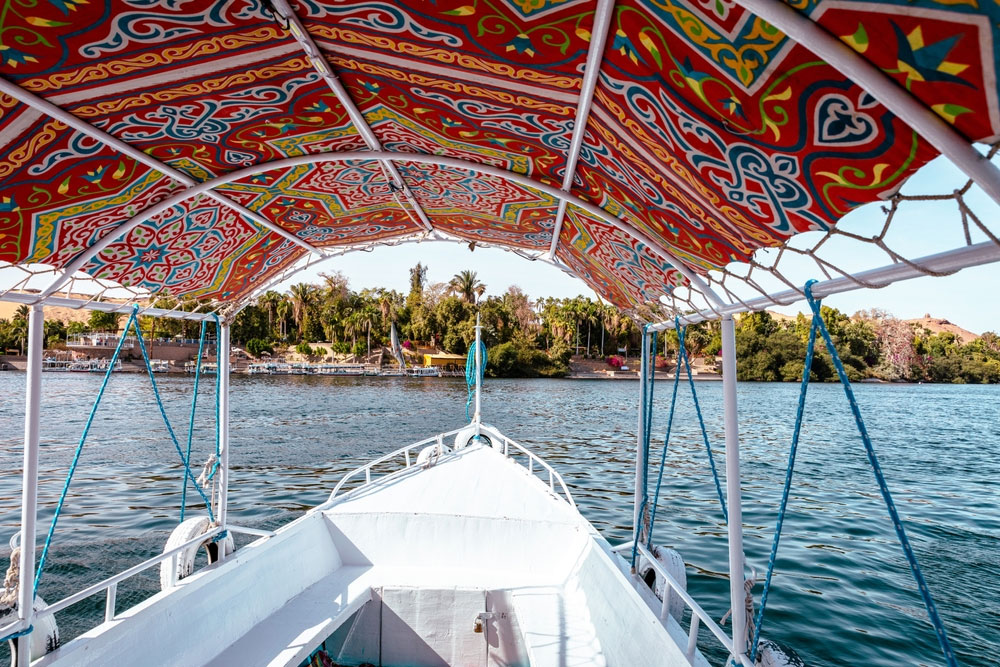
Nile River Cruise
Dinner Cruise: Book a dinner cruise on the Nile to enjoy stunning views of Cairo’s illuminated skyline. Indulge in Egyptian cuisine, music, and traditional dance.
Felucca Ride: Alternatively, you can take a tranquil felucca ride, a traditional sailboat, to experience the serenity of the river at sunset.
How to Get Around Cairo?
Cairo, a bustling metropolis with a rich history, offers various transportation options to help you navigate the city and explore its many attractions. Getting around Cairo can be an adventure in itself, and in this section, we’ll guide you through the different ways to move around the city efficiently.
1. Metro System
Cairo boasts a well-developed metro system that provides a convenient way to travel within the city:
Lines: The metro system consists of three lines—Line 1 (red), Line 2 (blue), and Line 3 (green). These lines cover many key areas of Cairo.
Affordable: Metro fares are inexpensive, making it a budget-friendly option for travelers.
Rush Hour: Be aware that during rush hours, the metro can get crowded, so plan accordingly.
2. Public Buses
Cairo has an extensive public bus network that serves both locals and tourists:
Routes: Buses cover most parts of the city, including areas not accessible by the metro.
Affordable: Bus fares are affordable, but the system can be somewhat confusing for newcomers.
Timings: Buses may not always run on a strict schedule, so be prepared for some waiting.
3. Taxis
Taxis are a common mode of transportation in Cairo:
Metered Taxis: Look for official yellow or white taxis with meters. Ensure the driver uses the meter or agree on a fare before starting your journey.
Negotiation: Taxi drivers often expect some negotiation, so be prepared to haggle for a fair price.
Traffic: Keep in mind that Cairo’s traffic can be challenging, especially during peak hours.
4. Ride-Sharing Apps
Ride-sharing apps like Uber and Lyft have gained popularity in Cairo:
Convenience: These apps offer a convenient and often more reliable alternative to traditional taxis.
Transparent Pricing: Prices are typically transparent, and you can see the fare before booking.
5. Microbuses
Microbuses are shared vans that serve specific routes in Cairo:
Routes: Microbuses are flexible and can reach areas not covered by other public transportation.
Affordable: They are usually affordable but may not always follow a fixed schedule.
Crowded: Microbuses can get crowded, so be prepared for a cozy ride.
6. Walking and Cycling
Exploring Cairo on foot or by bicycle can be a rewarding experience, especially in areas with less traffic:
Pedestrian-Friendly Areas: Downtown Cairo and some historic neighborhoods are pedestrian-friendly and offer a chance to explore at a relaxed pace.
Bike Rentals: Some areas offer bike rental services for those interested in cycling.
Where to Stay in Cairo?
Cairo, the sprawling capital of Egypt, offers a wide range of accommodations to suit every traveler’s preferences and budget. From luxury hotels to budget-friendly hostels and charming boutique options, you’ll find a variety of places to stay while exploring this vibrant city. In this section, we’ll guide you through different neighborhoods and areas to help you choose the best place to stay in Cairo.
1. Downtown Cairo
Downtown Cairo is a bustling area known for its historic landmarks, shopping, and vibrant street life:
Proximity: Staying in downtown puts you close to attractions like Tahrir Square, the Egyptian Museum, and Khan El Khalili Market.
Variety: You’ll find a mix of hotels, from luxury options to mid-range choices.
Accessibility: The area is well-connected by public transportation, including the metro.
2. Zamalek
Zamalek is an upscale island neighborhood on the Nile River:
Scenic Views: Enjoy picturesque views of the Nile and easy access to riverside promenades.
Cultural Attractions: Zamalek is home to many cultural institutions, including art galleries and theaters.
Luxury: You’ll find luxury hotels and boutique accommodations in this area.
3. Giza
Giza is famous for its proximity to the Pyramids and Sphinx:
Pyramids: Staying in Giza means you can wake up to views of these ancient wonders.
Variety: You’ll find a mix of hotels, including both luxury and budget options.
Traffic: Keep in mind that traffic can be heavy, especially during peak tourist seasons.
4. Maadi
Maadi is a quieter residential area known for its green spaces and expatriate community:
Peaceful: Maadi offers a tranquil escape from the hustle and bustle of central Cairo.
Restaurants: There are plenty of international restaurants and cafes to choose from.
Suburban Feel: While it’s a bit farther from some attractions, Maadi provides a suburban atmosphere.
5. Heliopolis
Heliopolis is a well-planned district with tree-lined streets and a mix of residential and commercial areas:
Shopping: It’s home to Citystars, one of the largest shopping malls in Cairo.
Cultural Sites: Visit historic landmarks like Baron Palace and Heliopolis Palace.
Variety: Heliopolis offers a range of accommodation options, including upscale hotels.
Conclusion
Cairo is a city that seamlessly blends the past and present, offering travelers an immersive experience in Egypt’s history and culture. By following our guide and being prepared, your visit to Cairo’s sightseeing places is sure to be a rewarding and unforgettable adventure.
Whether you’re exploring the ancient wonders of the pyramids or savoring the flavors of Egyptian cuisine, Cairo has something for every traveler to enjoy.
People Also Ask :
What's Cairo famous for?
Cairo is famous for its rich history and iconic landmarks, including the Pyramids of Giza, the Sphinx, the Egyptian Museum, and historic Islamic architecture.
What is the most beautiful part of Cairo?
The most beautiful part of Cairo can be a matter of personal preference, but many people find the historic district of Islamic Cairo with its ancient mosques, bazaars, and narrow streets to be particularly charming.
How do you spend a day in Cairo?
You can spend a day in Cairo by visiting the Pyramids of Giza, exploring the Egyptian Museum, taking a stroll along the Nile Corniche, and enjoying local cuisine at a traditional restaurant.
What is Cairo's most famous food?
Some of Cairo's famous foods include dishes like koshari (a vegetarian dish with pasta, rice, and lentils), falafel, shawarma, and stuffed grape leaves.
Is Cairo a walkable city?
Cairo is a bustling city with heavy traffic, so walking can be challenging in some areas. However, there are pedestrian-friendly parts of the city, especially in historic neighborhoods.
What is the most popular street in Cairo?
One of the popular streets in Cairo is Sharia Al-Muizz, also known as Al-Muizz Street, which is lined with historic Islamic architecture, mosques, and shops.
Is walking around Cairo safe?
Walking around Cairo can be safe in many areas, especially in well-traveled tourist districts. However, it's essential to be cautious of traffic, use designated pedestrian crossings, and be aware of your surroundings, especially when crossing busy streets. It's also advisable to respect local customs and dress modestly.
Plan your trip with ontravelx and get ready for a journey full of breathtaking sights and priceless memories.
Kindly Visit:
https://egypttimetravel.com/holidays-to-egypt-in-december/


